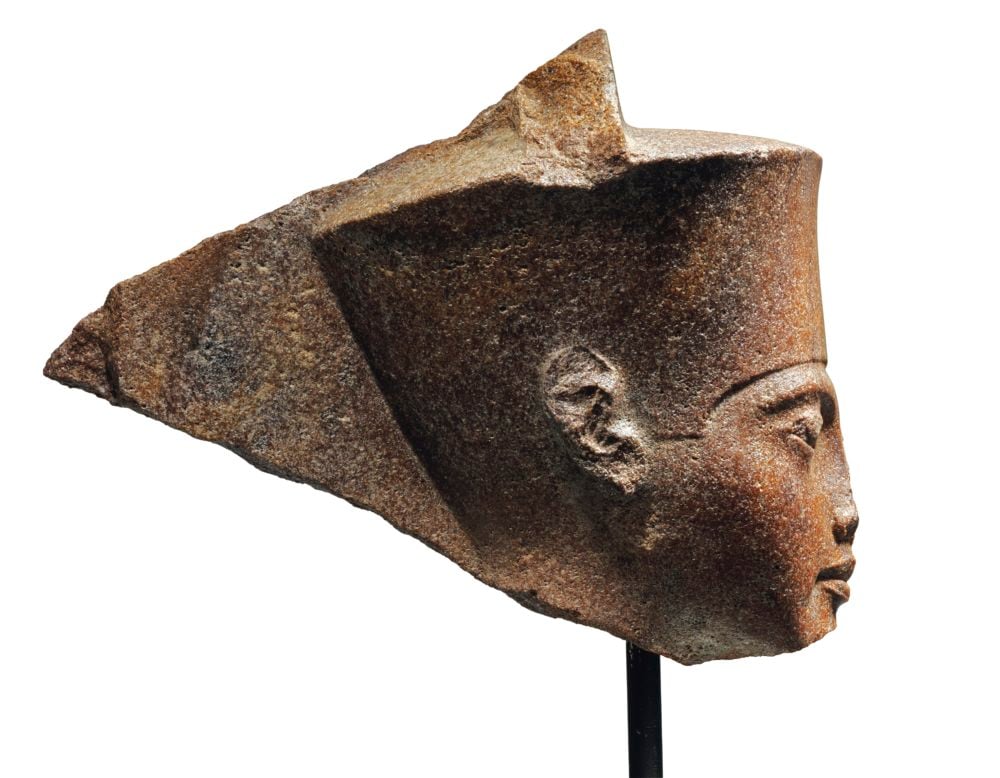
Egypt is taking legal action over the sale of a 3,000-year-old quartzite statue of King Tutankhamen that sold at Christie’s in London last week for £4.75 million ($5.96 million). The country has announced plans to file a civil suit seeking the repatriation of the antiquity, which it believes was looted from the Karnak Temple in the 1970s.
The effort to return the ancient artwork to Egypt is being led by the country’s antiquities minister, Khaled el-Enany. “They left us with no other option but to go to court to restore our smuggled antiquities,” he told the BBC. “We will leave no stone unturned until we repatriate the Tutankhamen bust.”
The head, which depicts the god Amun with the features of the boy pharaoh, was sold at Christie’s London on July 4 over Egypt’s objections. Shortly after the sale was announced in early June—with an estimate of £4 million (about $5 million)—Egypt began agitating for the artwork’s return. Under Egyptian law, any artifacts excavated after 1983 belong to the state, as does anything discovered before then that lacks legitimate title predating the 1983 law.
The circumstances of the head’s discovery are unknown, but the current owner, the Resandro Collection, a private German collection of Egyptian art, acquired it from Munich art dealer Heinz Herzer in 1985. Before that, it was in the hands of an Austrian dealer Joseph Messina, who is said to have bought it around 1973–74 from Prinz Wilhelm von Thurn und Taxis, who “reputedly had it in his collection by the 1960s,” according to the auction house press release.
The Egyptian head of the god Amun with features of the Pharaoh Tutankhamen. Photo courtesy Christie’s.
Herzer is linked to at least one high-profile instance of alleged antiquities looting, reports the Association for Research Into Crimes Against Art. The German dealer sold The Victorious Youth, sometimes referred to as The Getty Bronze, to Los Angeles’s J. Paul Getty Museum, which was later at the center of a scandal over illegal antiquities at the Getty.
ARCA also questioned the King Tut sculpture’s link to Von Thurn und Taxis, noting that there is no documented evidence that he had a significant collection of ancient artwork. (Christie’s, for its part, has noted that Von Thurn und Taxis is known to have inherited objects from his family, and that his great-grandfather’s collection included antiquities.)
“While ancient objects by their nature cannot be traced over millennia, Christie’s clearly carried out extensive due diligence verifying the provenance and legal title, establishing all required facts of recent ownership,” said an auction house representative in an email to artnet News. “Christie’s would not and do not sell any work where there isn’t clear title of ownership and a thorough understanding of modern provenance.” The house has noted that the work has been widely published and exhibited in the past without spurring a claim.
The Egyptian brown quartzite head of the God Amun with features of the Pharaoh Tutankhamen. (around 1333–1323 BC) Photo courtesy Christie’s.
Nevertheless, Egypt’s National Committee for Antiquities Repatriation has issued a statement criticizing the sale, saying “the committee expresses its deep discontent of the unprofessional behavior of the sale of Egyptian antiquities without providing the ownership documents and the evidences that prove its legal export from Egypt.”
The committee has also asked Interpol to investigate, in the hopes that the international crime agency can trace missing paperwork for the artifact. According to CTV News, the country’s national prosecutors are asking the UK to prevent the head’s export until it has uncovered ownership documents as well as papers proving it was legally exported from Egypt.
“The owners have given false information,” former Egyptian antiquities head Zahi Hawass told Agence France Presse ahead of the sale. “They have not shown any legal papers to prove its ownership.”